Anti-Histone H3 (tri methyl K27) antibody [mAbcam
advertisement
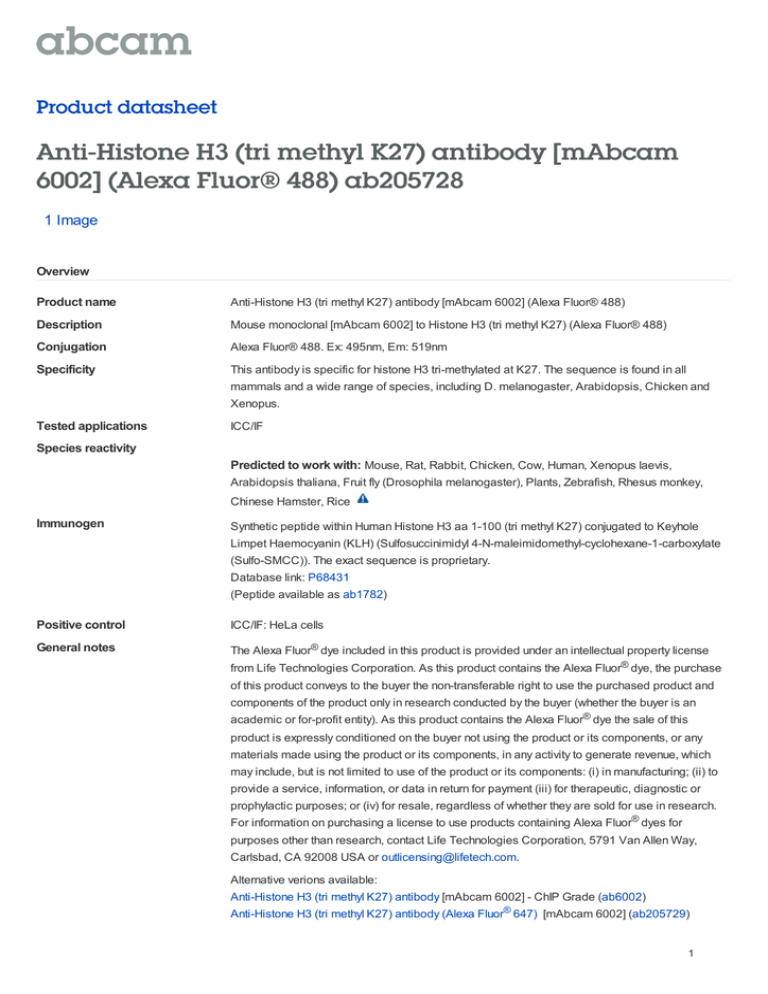
Product datasheet Anti-Histone H3 (tri methyl K27) antibody [mAbcam 6002] (Alexa Fluor® 488) ab205728 1 Image Overview Product name Anti-Histone H3 (tri methyl K27) antibody [mAbcam 6002] (Alexa Fluor® 488) Description Mouse monoclonal [mAbcam 6002] to Histone H3 (tri methyl K27) (Alexa Fluor® 488) Conjugation Alexa Fluor® 488. Ex: 495nm, Em: 519nm Specificity This antibody is specific for histone H3 tri-methylated at K27. The sequence is found in all mammals and a wide range of species, including D. melanogaster, Arabidopsis, Chicken and Xenopus. Tested applications ICC/IF Species reactivity Predicted to work with: Mouse, Rat, Rabbit, Chicken, Cow, Human, Xenopus laevis, Arabidopsis thaliana, Fruit fly (Drosophila melanogaster), Plants, Zebrafish, Rhesus monkey, Chinese Hamster, Rice Immunogen Synthetic peptide within Human Histone H3 aa 1-100 (tri methyl K27) conjugated to Keyhole Limpet Haemocyanin (KLH) (Sulfosuccinimidyl 4-N-maleimidomethyl-cyclohexane-1-carboxylate (Sulfo-SMCC)). The exact sequence is proprietary. Database link: P68431 (Peptide available as ab1782) Positive control ICC/IF: HeLa cells General notes The Alexa Fluor® dye included in this product is provided under an intellectual property license from Life Technologies Corporation. As this product contains the Alexa Fluor® dye, the purchase of this product conveys to the buyer the non-transferable right to use the purchased product and components of the product only in research conducted by the buyer (whether the buyer is an academic or for-profit entity). As this product contains the Alexa Fluor® dye the sale of this product is expressly conditioned on the buyer not using the product or its components, or any materials made using the product or its components, in any activity to generate revenue, which may include, but is not limited to use of the product or its components: (i) in manufacturing; (ii) to provide a service, information, or data in return for payment (iii) for therapeutic, diagnostic or prophylactic purposes; or (iv) for resale, regardless of whether they are sold for use in research. For information on purchasing a license to use products containing Alexa Fluor® dyes for purposes other than research, contact Life Technologies Corporation, 5791 Van Allen Way, Carlsbad, CA 92008 USA or outlicensing@lifetech.com. Alternative verions available: Anti-Histone H3 (tri methyl K27) antibody [mAbcam 6002] - ChIP Grade (ab6002) Anti-Histone H3 (tri methyl K27) antibody (Alexa Fluor® 647) [mAbcam 6002] (ab205729) 1 Properties Form Liquid Storage instructions Shipped at 4°C. Store at +4°C short term (1-2 weeks). Upon delivery aliquot. Store at -20°C. Stable for 12 months at -20°C. Store In the Dark. Storage buffer pH: 7.4 Preservative: 0.02% Sodium azide Constituents: PBS, 30% Glycerol, 1% BSA Purity IgG fraction Clonality Monoclonal Clone number mAbcam 6002 Isotype IgG Applications Our Abpromise guarantee covers the use of ab205728 in the following tested applications. The application notes include recommended starting dilutions; optimal dilutions/concentrations should be determined by the end user. Application ICC/IF Abreviews Notes 1/100. This product gave a positive signal in HeLa cells fixed with 4% formaldehyde (10 min) Target Function Core component of nucleosome. Nucleosomes wrap and compact DNA into chromatin, limiting DNA accessibility to the cellular machineries which require DNA as a template. Histones thereby play a central role in transcription regulation, DNA repair, DNA replication and chromosomal stability. DNA accessibility is regulated via a complex set of post-translational modifications of histones, also called histone code, and nucleosome remodeling. Sequence similarities Belongs to the histone H3 family. Developmental stage Expressed during S phase, then expression strongly decreases as cell division slows down during the process of differentiation. Post-translational modifications Acetylation is generally linked to gene activation. Acetylation on Lys-10 (H3K9ac) impairs methylation at Arg-9 (H3R8me2s). Acetylation on Lys-19 (H3K18ac) and Lys-24 (H3K24ac) favors methylation at Arg-18 (H3R17me). Citrullination at Arg-9 (H3R8ci) and/or Arg-18 (H3R17ci) by PADI4 impairs methylation and represses transcription. Asymmetric dimethylation at Arg-18 (H3R17me2a) by CARM1 is linked to gene activation. Symmetric dimethylation at Arg-9 (H3R8me2s) by PRMT5 is linked to gene repression. Asymmetric dimethylation at Arg-3 (H3R2me2a) by PRMT6 is linked to gene repression and is mutually exclusive with H3 Lys-5 methylation (H3K4me2 and H3K4me3). H3R2me2a is present at the 3' of genes regardless of their transcription state and is enriched on inactive promoters, while it is absent on active promoters. Methylation at Lys-5 (H3K4me), Lys-37 (H3K36me) and Lys-80 (H3K79me) are linked to gene activation. Methylation at Lys-5 (H3K4me) facilitates subsequent acetylation of H3 and H4. 2 Methylation at Lys-80 (H3K79me) is associated with DNA double-strand break (DSB) responses and is a specific target for TP53BP1. Methylation at Lys-10 (H3K9me) and Lys-28 (H3K27me) are linked to gene repression. Methylation at Lys-10 (H3K9me) is a specific target for HP1 proteins (CBX1, CBX3 and CBX5) and prevents subsequent phosphorylation at Ser-11 (H3S10ph) and acetylation of H3 and H4. Methylation at Lys-5 (H3K4me) and Lys-80 (H3K79me) require preliminary monoubiquitination of H2B at 'Lys-120'. Methylation at Lys-10 (H3K9me) and Lys-28 (H3K27me) are enriched in inactive X chromosome chromatin. Phosphorylated at Thr-4 (H3T3ph) by GSG2/haspin during prophase and dephosphorylated during anaphase. Phosphorylation at Ser-11 (H3S10ph) by AURKB is crucial for chromosome condensation and cell-cycle progression during mitosis and meiosis. In addition phosphorylation at Ser-11 (H3S10ph) by RPS6KA4 and RPS6KA5 is important during interphase because it enables the transcription of genes following external stimulation, like mitogens, stress, growth factors or UV irradiation and result in the activation of genes, such as c-fos and c-jun. Phosphorylation at Ser-11 (H3S10ph), which is linked to gene activation, prevents methylation at Lys-10 (H3K9me) but facilitates acetylation of H3 and H4. Phosphorylation at Ser-11 (H3S10ph) by AURKB mediates the dissociation of HP1 proteins (CBX1, CBX3 and CBX5) from heterochromatin. Phosphorylation at Ser-11 (H3S10ph) is also an essential regulatory mechanism for neoplastic cell transformation. Phosphorylated at Ser-29 (H3S28ph) by MLTK isoform 1, RPS6KA5 or AURKB during mitosis or upon ultraviolet B irradiation. Phosphorylation at Thr-7 (H3T6ph) by PRKCBB is a specific tag for epigenetic transcriptional activation that prevents demethylation of Lys-5 (H3K4me) by LSD1/KDM1A. At centromeres, specifically phosphorylated at Thr-12 (H3T11ph) from prophase to early anaphase, by DAPK3 and PKN1. Phosphorylation at Thr-12 (H3T11ph) by PKN1 is a specific tag for epigenetic transcriptional activation that promotes demethylation of Lys-10 (H3K9me) by KDM4C/JMJD2C. Phosphorylation at Tyr-42 (H3Y41ph) by JAK2 promotes exclusion of CBX5 (HP1 alpha) from chromatin. Monoubiquitinated by RAG1 in lymphoid cells, monoubiquitination is required for V(D)J recombination (By similarity). Ubiquitinated by the CUL4-DDB-RBX1 complex in response to ultraviolet irradiation. This may weaken the interaction between histones and DNA and facilitate DNA accessibility to repair proteins. Cellular localization Nucleus. Chromosome. Anti-Histone H3 (tri methyl K27) antibody [mAbcam 6002] (Alexa Fluor® 488) images ab205728 staining Histone H3 (tri methyl K27) in HeLa cells. The cells were fixed with 4% formaldehyde (10min), permeabilized with 0.1% Triton X-100 for 5 minutes and then blocked with 1% BSA/10% normal goat serum/0.3M glycine in 0.1% PBS-Tween for 1h. The cells were then incubated overnight at +4°C with ab205728 at 1/100 dilution (shown in green) and ab195889, Mouse monoclonal [DM1A] to alpha Tubulin (Alexa Fluor® 594), at 2µg/ml (shown in red). Nuclear DNA was Immunocytochemistry/ Immunofluorescence - labelled with DAPI (shown in blue). Anti-Histone H3 (tri methyl K27) antibody Image was taken with a confocal microscope [mAbcam 6002] (Alexa Fluor® 488) (ab205728) (Leica-Microsystems, TCS SP8). 3 Please note: All products are "FOR RESEARCH USE ONLY AND ARE NOT INTENDED FOR DIAGNOSTIC OR THERAPEUTIC USE" Our Abpromise to you: Quality guaranteed and expert technical support Replacement or refund for products not performing as stated on the datasheet Valid for 12 months from date of delivery Response to your inquiry within 24 hours We provide support in Chinese, English, French, German, Japanese and Spanish Extensive multi-media technical resources to help you We investigate all quality concerns to ensure our products perform to the highest standards If the product does not perform as described on this datasheet, we will offer a refund or replacement. For full details of the Abpromise, please visit http://www.abcam.com/abpromise or contact our technical team. Terms and conditions Guarantee only valid for products bought direct from Abcam or one of our authorized distributors 4
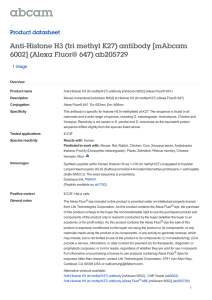
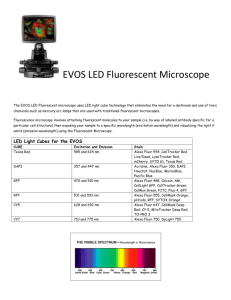
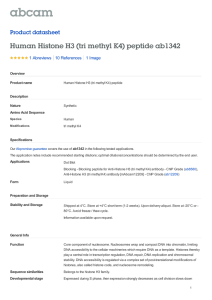
![Mouse IgG2b, kappa monoclonal [7E10G10] - Isotype](http://s2.studylib.net/store/data/012909847_1-9b2bb6a95a189600a77028a367bfe36d-300x300.png)
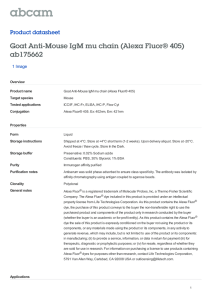
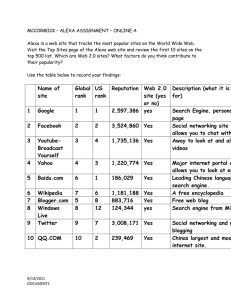
![Anti-CD147 antibody [EPR4053] (Alexa Fluor® 488) ab205450](http://s2.studylib.net/store/data/012963350_1-9f029359b62a58420c39721f185df4dd-300x300.png)
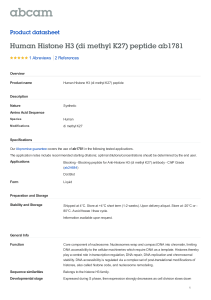
![Anti-BNIP3 antibody [ANa40] (Alexa Fluor® 647) ab196706](http://s2.studylib.net/store/data/012083394_1-2ff7db27c0d6912ecfc1f982c1a7d990-300x300.png)